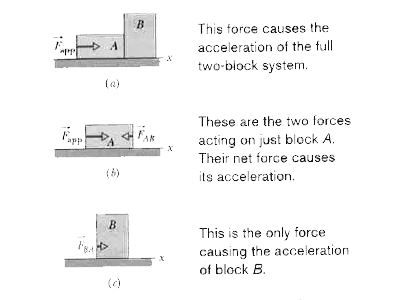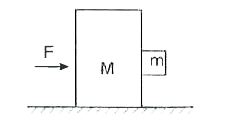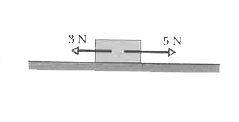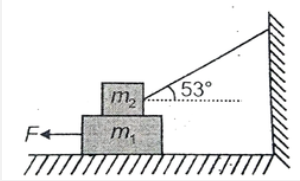In Fig. 5-26a, a constant horizontal force →Fapp of magnitude 20 N is applied to block A of mass mA=4.0 kg, which pushes against block B of mass mB=6.0 kg. The blocks slide over a frictionless surface, along an x axis.
(a) What is the acceleration of the blocks ?
Serious Error: Because force Fapp is applied directly to block A, we use Newton's second law to relate that force to the acceleration →a of block A. because the motion is along the x axis, we use that law for x components (Fnet, x=max), writing it as
Fapp=mAα.
However, this is seriously wrong because →Fapp is not the only horizontal force acting on block A. There is also the force →FAD from block B (Fig. 5-26b).
Dead-End Solution: Let us now include force →FAB by writing, again for the x axis,
Fapp−FAB=mAα.

Figure 5-26 (a) A constant horizontal force →Fapp is applied to block A, which pushes against block B. (b) Two horizontal forces act on block A. (c) Only one horizontal force acts on block B.
(We use the minus sign to include the direction of →FAB.) Because FAB is a second unkon, we cannot solve this equation for a.
Successful Solution: Because of the direction in which force →Fapp is applied, the two blocks form a rigidly connected system. We can relate the net force on the system to the acceleration of the system with Newton's second law. Here, once again for the x axis, we can write that law as
Fapp=(mA+mB)α,
where now we properly apply →Fapp to the system with total mass mA+mB. Solving for a and substituting known values, we find
a=FappmA+mB=20 N)4.0 kg+6.0 kg)=2.0 m/s2.
Thus, the acceleration of the system and of each block is in the positive direction of the x axis and has the magnitude 2.0 m/s2.
(b) What is the (horizontal) force →FBA on block B from block A (Fig. 5-26c) ?
We can relate not force on block B to the block.s acceleration with Newton.s second law.
Calculation: Here we can write that law, still for components along the x axis, as
FBA=MBα,
which, with known values, gives
FBA=(6.0 kg)(2.0 m/s2)=12 N.
Thus, force →FBA is in the positive direction of the x axis and has a magnitude of 12 N.
Topper's Solved these Questions
- FORCE AND MOTION - I BOOK - RESNICK AND HALLIDAYCHAPTER - FORCE AND MOTION - I EXERCISE - CHECKPOINT
5 Videos
- FORCE AND MOTION - I BOOK - RESNICK AND HALLIDAYCHAPTER - FORCE AND MOTION - I EXERCISE - PROBLEMS
52 Videos
- FLUIDSBOOK - RESNICK AND HALLIDAYCHAPTER - FLUIDSEXERCISE - PRACTICE QUESTIONS (Integer Type )
5 Videos
- FORCE AND MOTION-IIBOOK - RESNICK AND HALLIDAYCHAPTER - FORCE AND MOTION-IIEXERCISE - PRACTICE QUESTIONS (Integer Type)
1 Videos
Similar Questions
In Fig. 5-54a, a constant horizontal force →Fa is applied to block A, which pushes against block B with a 15.0 N force directed horizontally to the right. In Fig. 5-54b, the same force →Fa is applied to block B, now block A pushes on block B with a 10.0 N force directed horizontally to the left. The blocks have a combined mass of 12.0 kg. What are the magnitudes of (a) their acceleration in Fig. 5-54a and (b) force →Fa ?

View SolutionA horizontal force F pushes wedge of mass M on a smooth horizontal surface. A block of mass m is stationary to the wedge, then:

View Solution
Knowledge Check
A single horizontal force F is applied to a block of mass M1 which is in contact with another block of mass M2. If the surfaces are frictionless, the force between the blocks is
 AM1FM2BM1M2gM1+M2CM2FM1+M2DNone of these
AM1FM2BM1M2gM1+M2CM2FM1+M2DNone of theseA block (A) of mass 3 kg in contact with a second block (B) of mass 2 kg rests on a frictionless horizontal surface. A horizontal force of 20 N is applied to push the block A. What is the force with which the block A pushes the block B?
A4NB6NC8ND10NA horizontal force F pushes a 4 kg block (A) which pushes against a 2 kg block (B) as shown. The blocks have an acceleration of 3m/s2 to the right. There is no friction between the blocks and the surfaces on which they slide. What is the net force B exerts on A ?
 A6N to the rightB12 N to the rightC6 N to the leftD12 N to the left
A6N to the rightB12 N to the rightC6 N to the leftD12 N to the left
A block of mass m = 10 kg is pulled by a force F = 100 N at an angle θ=30∘ with the horizontal along a smooth horizontal surface. What is the acceleration of the block? (g=10m/s2)

View SolutionA block of mass m = 10 kg is pulled by a force F = 100 N at an angle θ=30∘ with the horizontal along a smooth horizontal surface. What is the acceleration of the block? (g=10m/s2)

View SolutionThe figure here shows two horizontal forces acting on a block on a frictionless floor. If a third horizontal force →F3 also acts on the block, what are the magnitude and direction of →F3 when the block is (a) stationary and (b) moving to the left with a constant speed of 5 m/s ?

View SolutionCalculate the Force (F) required to cause the block of mass m1=20kg just to slide under the block of mass m2=10kg [ coefficient of friction μ=0⋅25 for all surfaces ]

View SolutionCalculate the Force (F) required to cause the block of mass m1=20kg just to slide under the block of mass m2=10kg [ coefficient of friction μ=0⋅25 for all surfaces ]

View Solution
